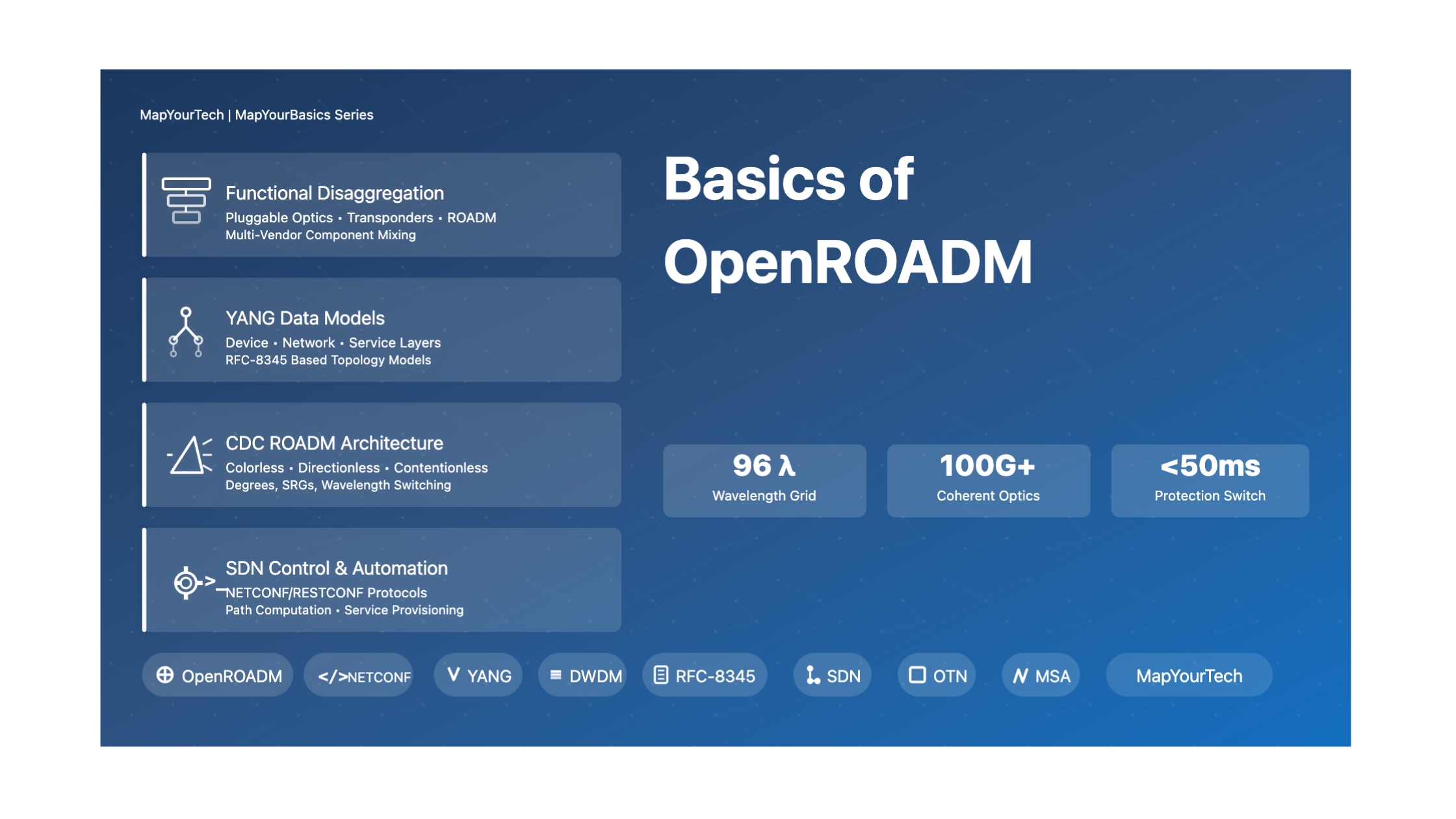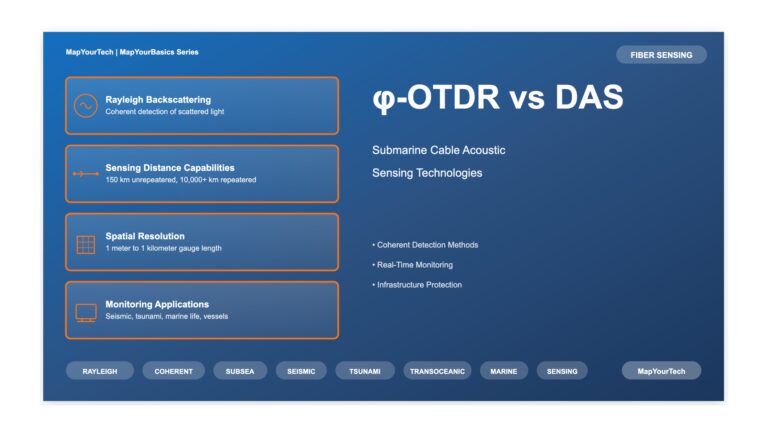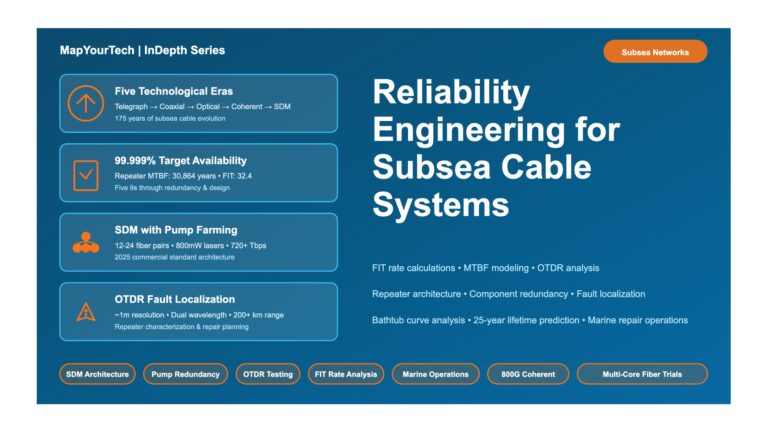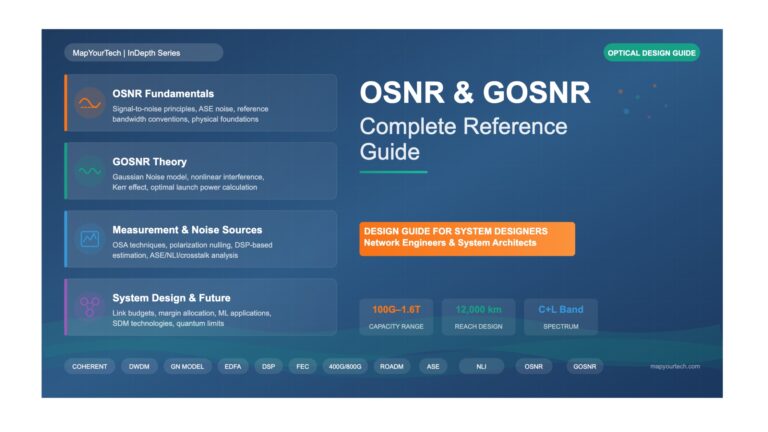14 min read

Basics of OpenROADM
Comprehensive Visual Educational Guide with Animated Illustrations
Introduction
OpenROADM (Reconfigurable Optical Add-Drop Multiplexer) represents a transformative initiative in optical networking that addresses one of the industry's most persistent challenges: vendor lock-in and proprietary systems. As network operators face increasing demands for bandwidth, flexibility, and cost-efficiency, OpenROADM emerges as a collaborative solution that enables truly interoperable, disaggregated optical networks.
What is OpenROADM?
OpenROADM is a Multi-Source Agreement (MSA) initiated by leading network operators including AT&T, Orange, Deutsche Telekom, KDDI, and others. It defines comprehensive interoperability specifications for ROADM networks, including disaggregated optical components (ROADMs, transponders, and pluggable optics), standardized YANG data models for device, network, and service management, and open APIs using NETCONF/RESTCONF protocols.
Why OpenROADM Matters
Traditional optical networks have been plagued by vendor proprietary implementations, making it nearly impossible to mix equipment from different vendors. This creates several critical problems:
- Vendor Lock-in: Once deployed, network operators are tied to a single vendor ecosystem, limiting negotiating power and innovation options
- Higher Costs: Lack of competition leads to inflated equipment and service costs
- Limited Innovation: Proprietary systems slow the pace of technological advancement
- Complex Management: Each vendor requires unique management systems and expertise
- Scalability Challenges: Expanding networks becomes expensive and complicated
OpenROADM solves these challenges by establishing a common framework that enables true multi-vendor interoperability while maintaining high performance and reliability.
OpenROADM Concept: From Vendor Lock-in to Open Ecosystem
Animated visualization showing the transformation from proprietary single-vendor networks to open, multi-vendor OpenROADM networks
Real-World Impact and Applications
OpenROADM is not just a theoretical framework—it has been successfully demonstrated in multi-vendor field trials and is being deployed in production networks worldwide. Major telecommunications operators use OpenROADM to:
- Metro Networks: Building cost-effective, flexible metro DWDM networks with rapid service turn-up capabilities
- Data Center Interconnection: Connecting data centers with high-capacity optical links using equipment from multiple vendors
- 5G Fronthaul/Backhaul: Supporting the massive bandwidth requirements of 5G networks with disaggregated optical infrastructure
- Cloud Connectivity: Enabling dynamic, on-demand optical connectivity for cloud service providers
- Network Modernization: Gradually transitioning legacy proprietary networks to open, software-defined architectures
What You'll Learn in This Guide
This comprehensive visual guide will take you on a journey through the fundamentals of OpenROADM, from basic concepts to advanced implementations. You'll explore:
- The historical context and evolution of optical networking standards leading to OpenROADM
- Core architectural principles including functional disaggregation and the three-layer network model
- Technical deep-dives into ROADM components, transponders, and pluggable optics specifications
- YANG data models for device, network, and service management
- SDN control and automation using NETCONF/RESTCONF protocols
- Path computation algorithms and service provisioning workflows
- Real-world implementation examples and multi-vendor interoperability demonstrations
- Best practices for planning, deploying, and operating OpenROADM networks
Each major concept is accompanied by detailed animated SVG visualizations that bring the technology to life, making complex optical networking principles accessible and engaging for learners at all levels.
Historical Context & Evolution
To truly understand the significance of OpenROADM, we must first examine the evolution of optical networking and the challenges that led to its creation. The journey from fixed, proprietary ROADM systems to today's open, software-defined networks represents decades of technological advancement and industry collaboration.
The Era of Proprietary Optical Networks (1990s-2010s)
In the early days of DWDM (Dense Wavelength Division Multiplexing) networks, equipment vendors developed highly integrated, proprietary systems. While these systems were technologically impressive, they created significant challenges:
- Closed Architectures: Each vendor's ROADM equipment used proprietary control protocols, making multi-vendor integration virtually impossible
- Fixed Grid Systems: Early systems used fixed 50 GHz or 100 GHz channel spacing, limiting spectral efficiency
- Manual Configuration: Network operators relied on element management systems (EMS) specific to each vendor, requiring extensive manual configuration
- Limited Automation: Service provisioning could take days or weeks, involving multiple manual steps and coordination
Evolution Timeline: From Proprietary to Open Optical Networks
Interactive timeline showing key milestones in optical networking leading to OpenROADM
The OpenROADM Initiative (2016-Present)
In 2016, AT&T took the bold step of initiating the OpenROADM Multi-Source Agreement, inviting other major network operators and equipment vendors to collaborate on defining truly open optical networking standards. The initiative quickly gained momentum, attracting participants including:
- Network Operators: AT&T, Orange, Deutsche Telekom, KDDI, SK Telecom, Telecom Italia, RosTelecom, Saudi Telecom, and others
- Equipment Vendors: Ciena, Fujitsu, Nokia, Cisco, Infinera/Coriant, ECI Telecom, Juniper, and more
- Research Organizations: CESNET, SURFnet, ViewQwest, and academic institutions
The OpenROADM MSA focused on three fundamental objectives:
- Functional Disaggregation: Separating optical functions (ROADM, transponder, pluggable optics) to enable mix-and-match deployments
- Standardized Interfaces: Defining optical interface specifications (Single-Wave and Multi-Wave) for interoperability
- Open Management: Creating comprehensive YANG data models and NETCONF/RESTCONF APIs for vendor-agnostic network control
Key Milestone: In 2017, the industry witnessed the first multi-vendor OpenROADM demonstration, where ROADMs and transponders from three different vendors successfully interoperated in a live network environment. This proof-of-concept validated the OpenROADM approach and accelerated industry adoption.
OpenROADM Release Evolution
Since its inception, OpenROADM has evolved through multiple releases, each adding new capabilities and refinements:
- Release 1.x (2016-2017): Initial specifications for 100G systems with fixed 50 GHz grid, colorless/directionless ROADM functionality, and basic YANG models
- Release 2.x (2018): Added flexgrid support, enhanced spectral efficiency, improved YANG models, and expanded device capabilities
- Release 3.x-7.x (2019-2021): Continuous improvements including OTN support, enhanced telemetry, better fault management, and refined control protocols
- Release 8.x-13.x (2022-2024): Advanced features including 400G support, improved path computation, enhanced automation capabilities, and integration with broader SDN frameworks
Each release maintains backward compatibility while introducing new features, ensuring that early adopters can continue to benefit from the OpenROADM ecosystem as it matures.
Core Concepts & Fundamentals
At its heart, OpenROADM is built on several fundamental principles that distinguish it from traditional proprietary optical networking approaches. Understanding these core concepts is essential for appreciating how OpenROADM achieves true multi-vendor interoperability.
Functional Disaggregation: The Foundation of Openness
Traditional optical networks integrate multiple functions into monolithic, vendor-specific systems. OpenROADM takes a fundamentally different approach through functional disaggregation—separating optical networking into three distinct functional components:
- Pluggable Optics: Client-side and coherent pluggable transceivers that can be sourced from multiple vendors and inserted into transponders or routers
- Transponder: Converts client signals (100GbE, OTU4) into DWDM signals for transport across the optical network
- ROADM (Optical Line System): The wavelength switching infrastructure including amplifiers, couplers, wavelength selective switches (WSS), and optical multiplexers/demultiplexers
Functional Disaggregation: Three Independent Components
Animated visualization of how OpenROADM separates optical functions into interoperable building blocks
This disaggregation enables network operators to select the best components from different vendors based on performance, cost, and feature requirements—a capability impossible in traditional integrated systems.
Colorless, Directionless, and Contentionless (CDC) Architecture
A key innovation in OpenROADM is the specification of CDC ROADM architecture:
- Colorless: Any wavelength can be added or dropped at any add/drop port, eliminating the need for wavelength-specific port assignments
- Directionless: Any add/drop port can reach any ROADM degree (direction), providing full connectivity flexibility
- Contentionless: Multiple wavelengths of the same frequency can be added/dropped simultaneously without contention
CDC architecture dramatically simplifies network planning, reduces operational complexity, and improves network utilization by eliminating artificial constraints imposed by hardware limitations.
YANG Data Models: The Language of Interoperability
OpenROADM defines comprehensive YANG (Yet Another Next Generation) data models that serve as the lingua franca for multi-vendor network management. These models are organized into three hierarchical layers:
- Device Model: Vendor-specific equipment details including circuit packs, ports, physical connections, and hardware capabilities
- Network Model: Vendor-agnostic network topology representing ROADM degrees, add/drop groups (SRGs), wavelength assignments, and OTN elements
- Service Model: High-level service definitions for end-to-end optical connectivity requests and service lifecycle management
By standardizing these data models, OpenROADM enables a single SDN controller to manage equipment from multiple vendors using consistent APIs, eliminating the need for vendor-specific element management systems.
OpenROADM Three-Layer Network Architecture
Based on RFC-8345, showing CLLI, OpenROADM-Network, and OpenROADM-Topology layers with OTN overlay
Technical Architecture & Components
OpenROADM's technical architecture is meticulously designed to enable true multi-vendor interoperability while maintaining the performance and reliability required for carrier-grade optical networks. This section explores the detailed architecture of each major component and how they interact through standardized interfaces.
ROADM Architecture: Degrees and SRGs
The ROADM (Reconfigurable Optical Add-Drop Multiplexer) is the heart of the optical line system. OpenROADM models ROADMs using two fundamental building blocks:
ROADM Degree (Direction)
A degree represents a physical direction in a ROADM node, connecting to adjacent ROADM nodes via fiber. Each degree contains:
- TTP (Trail Termination Points): Tx and Rx points connecting to pre-amplifier and booster amplifier ports
- CTP (Connection Termination Points): Tx and Rx points for internal connections to wavelength selective switches (WSS)
- Wavelength Capacity: Supports up to 96 wavelengths in fixed grid or flexible spectrum allocation in flexgrid
SRG (Shared Risk Group / Add-Drop Group)
An SRG provides add/drop functionality for local transponders. Each SRG contains:
- CP (Connection Points): Tx and Rx ports connecting to internal WSS
- PP (Port Pairs): Physical add/drop port pairs connecting to transponders or external pluggables
- Colorless/Directionless Capability: Any wavelength can be added/dropped through any port pair to any degree
ROADM Internal Architecture: Degrees and SRGs
Detailed view of ROADM degree components, wavelength selective switches, and add/drop groups
This architecture enables complete flexibility: any wavelength arriving at any degree can be express-routed to any other degree, or add/dropped through any SRG to reach any transponder—a true colorless, directionless implementation.
Transponder and OTN Functionality
Transponders in OpenROADM networks perform critical signal conversion and management functions:
- Client Signal Mapping: Converts client signals (100GbE, OTU4) into DWDM-compatible optical signals
- Forward Error Correction (FEC): Applies advanced FEC (HD-FEC, SD-FEC) to extend optical reach
- OTN Encapsulation: Provides OTN (Optical Transport Network) framing for service-level management
- Modulation Formats: Supports various modulation schemes (DP-QPSK, DP-16QAM, DP-8QAM) for optimizing capacity vs. reach
Optical Interface Specifications
OpenROADM defines two critical optical interface specifications:
Single-Wave (W) Interface
Defines how pluggable optics and transponders interoperate:
- Initial release: 100G with Cortina HD-FEC
- Wavelength range: C-band (1530-1565 nm)
- Channel spacing: Compatible with flexgrid
- Power levels: Specified transmit and receive power ranges
Multi-Wave (MW) Interface
Defines how ROADMs interoperate with each other:
- Fixed grid: 50 GHz spacing, 96 wavelengths
- Flexgrid: Flexible spectrum allocation (planned for later releases)
- OSC (Optical Supervisory Channel): Gigabit Ethernet for short spans, 100 Megabit for long spans
- Power management: Automated power leveling and tilt correction
End-to-End Signal Flow in OpenROADM Network
Complete signal path from client equipment through transponders, ROADMs, and back to destination
SDN Control and Automation
One of OpenROADM's most transformative aspects is its comprehensive approach to Software-Defined Networking (SDN) control. By standardizing management interfaces and data models, OpenROADM enables true vendor-agnostic network automation.
NETCONF/RESTCONF Protocols
OpenROADM mandates the use of NETCONF (Network Configuration Protocol) and RESTCONF for device management:
- NETCONF: XML-based protocol for configuration and operational data retrieval, providing atomic transactions and rollback capabilities
- RESTCONF: HTTP-based protocol offering RESTful API access to YANG models, ideal for web-based applications
- gNMI: While not mandatory, some OpenROADM implementations also support gNMI (gRPC Network Management Interface) for enhanced performance
The OpenROADM Controller Architecture
A typical OpenROADM controller implementation (such as TransportPCE based on OpenDaylight) consists of several key components:
- Service Handler: Receives service requests from northbound applications and orchestrates end-to-end service creation
- Path Computation Engine (PCE): Calculates optimal paths through the network considering constraints like wavelength availability, diversity, and QoS requirements
- Topology Management: Maintains real-time network topology based on LLDP discovery and device inventory
- Renderer: Translates high-level service requests into device-specific configurations and pushes them via NETCONF
- OLM (Optical Link Manager): Monitors and manages optical power levels, OSNR, and other physical layer parameters
OpenROADM SDN Controller Architecture
Complete controller stack showing service handler, PCE, renderer, and device interactions
Service Provisioning Workflow
When a network operator requests a new optical service, the OpenROADM controller executes a sophisticated workflow:
- Service Request Reception: Service handler receives request specifying source, destination, bandwidth, and constraints
- Path Computation: PCE calculates optimal path considering wavelength availability, diversity requirements, and latency constraints
- Wavelength Assignment: Controller selects appropriate wavelength across all network segments
- Resource Reservation: Controller marks resources as reserved in topology database
- Configuration Generation: Renderer generates device-specific NETCONF configurations
- Device Provisioning: Controller pushes configurations to all devices in the service path
- Service Activation: OLM verifies optical power levels and service becomes operational
- Monitoring: Continuous telemetry collection ensures service health
This entire process, which traditionally required hours or days of manual configuration, can be completed in minutes with OpenROADM automation.
Key Takeaways
Functional Disaggregation
OpenROADM separates pluggable optics, transponders, and ROADMs into independently sourceable components
YANG Data Models
Comprehensive standardized models at device, network, and service layers enable vendor-agnostic management
CDC Architecture
Colorless, Directionless, Contentionless ROADMs provide maximum flexibility and simplified operations
SDN Control
NETCONF/RESTCONF protocols enable full automation and rapid service provisioning
Multi-Vendor Interoperability
Successfully demonstrated in lab and field trials with equipment from multiple vendors
Three-Layer Network Model
CLLI, OpenROADM-Network, and OpenROADM-Topology layers provide hierarchical abstraction
Optical Interfaces
Single-Wave (W) and Multi-Wave (MW) specifications ensure optical interoperability
Open Standards
Based on IETF RFC-8345 and ITU-T standards for maximum industry alignment
Production Ready
Deployed in operational networks by major telecommunications operators worldwide
Continuous Evolution
Active MSA community continues to enhance specifications with new features and capabilities
Developed by MapYourTech Team
For educational purposes in optical networking and telecommunications systems
Note: This visual guide is based on OpenROADM MSA specifications (Release 8.0+), industry white papers, technical documentation, and real-world implementation experiences. All diagrams and animations are created for educational purposes based on content extracted from project documents. Specific implementations may vary based on equipment vendors, network topology, and regulatory requirements. Always consult with qualified network engineers and follow vendor documentation for actual deployments. For the most current OpenROADM specifications, visit openroadm.org.
Unlock Premium Content
Join over 400K+ optical network professionals worldwide. Access premium courses, advanced engineering tools, and exclusive industry insights.
Already have an account? Log in here




